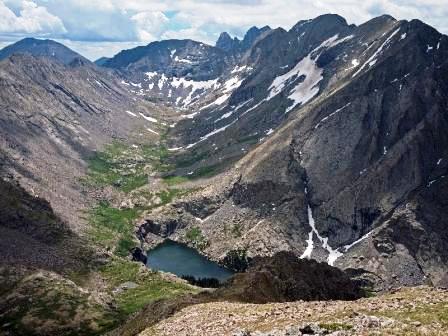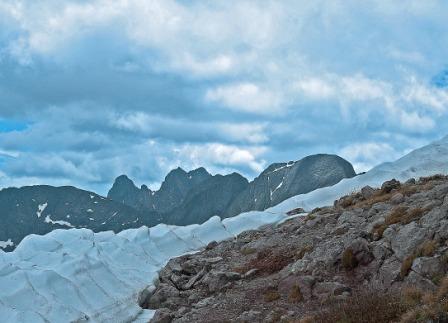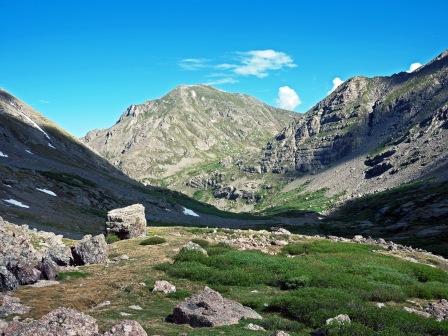In The Hard Heart Of The Sangres
Some Mountains Are Manly, Some Not

Unamed summits in Colorado are usually identified by a number reflecting altitude, and I have a thing for lovely 13,546. She stands poised and modest out front of the sharp toothy Crestone fourteeners. Around summer solstice the sun rises from her slender left shoulder.
Early one Friday in June I decided to go up there and see what I could see looking the other way, down 5,000 vertical feet. I packed up and walked off in a cloud of mosquitoes, heading into the twin basins where Willow Creek rises in the hard conglomerate heart of the Sangre de Cristo range. The east basin gives access to the fourteeners Kit Carson and Challenger. The north basin is dominated by the near fourteener Adams peak and by 13,546, my mountain.
It was a little early in the season for the average summertime peak baggers – too much snow – so I had the camping zone below Willow Lake to myself except for a curious doe and few frolicking big horn sheep. The hard-core climbers would be sleeping high in the rocks above the lake.
Next morning I bushwacked up the east side of the north creek until I could cross the water and ascend the unnamed mountain. I contoured back and forth in the tundra and rock slides. There were rare bristle cone pine at timberline, and for a long time I could hear the water falling into the lake, a teaspoon of water far below.

At noon beside a snow cornice I signed the Colorado Mountain Club register on the summit of 13,546. Someone had written in a name: Montaña Mujer. The last person to sign the register was a solo woman from Golden, Colo., in late September 2009, and I wondered if she was sad.
I wandered back and forth on the flat summit taking pictures until the clouds moved in. The view of the fourteeners was stunning, and on the other side the roads of the Baca Grande subdivision were like a map. I saw where my house would be, but the dark asphalt roof does not stand out. (Or perhaps, as on satellite photos before 2004, it was not there.) Distant thunder told me to go down.
The night before, in the white noise of rain on Big Agnes (she is a small tent) I read by headlamp a story by Borges called “The Immortal” about a searcher for a river whose waters make you live forever. What appeared to him in the distance as a magnificent city beside this river turned out to be a conglomeration of rubble from many such cities. And the place was inhabited by troglodytes that were fearless because they knew they could not die and did not give a shit about the past or the future for the same reason. Of the trog that kept following him without a word, the narrator said:
“I thought that perhaps there were no objects for him, only a vertiginous and continuous play of extremely brief impressions. I thought of a world without memory, without time; I considered the possibility of a language without nouns, a language of impersonal verbs or indeclinable epithets.”
Borges was a scholar and librarian, so a world without memory or symbols would have been perverse. And because he also was a literary trickster I wondered if this clever essay were a subtle critique of “living in the moment.” By logical extension (and Borges was logical), a cultural denial of the past and the future would bring forth a generation of Trogs.
But I was descending a high mountain and it was now raining. Living in the moment, which is to say overcoming habitual thought of past and future events, was necessary. No high mountain is a dream-filled walk-up, and a stumble on a loose rock can get you hurt. You need immediate perception, step by step. Abandon attachment to conceptual thinking, the Buddhists say. Do not symbolize. So instead of conceptualizing, “Oh what a nice yellow buttercup,” you are aware of “pleasant yellow thing, gone.” Instead of, “That rock is a good example of Crestone Conglomerate,” you think, “instability, careful, gone.” In other words, when you are alone in the wilderness don’t talk to yourself.
At camp I spread my wet clothes on a deadfall to dry in the late sun. Mosquitoes landed by the dozens on my legs, which I defended with Deet. As I rummaged for a freeze-dried dinner I began to tremble wildly. I dove into my down bag, zipped the mosquito net tight, eventually overcoming the hypothermia. No reading that night.
On Sunday morning above the lake I passed a camp of climbers having coffee on the tundra in the sun. One wanted to talk, and I had time. Why are there so many mosquitoes this year? They happen every June, I said. Was there a place to eat lunch down in Crestone? The Sage, owned by a wonderful couple from Bhutan. Bhutan? he said. A second man joined the conversation. A woman stayed by the tents enjoying the morning.
They had climbed Challenger and Kit Carson the day before by the standard routes and the snow was soft on the surface but hard below so you didn’t posthole in. They were good climbers. The snow, I thought, stops the others, or ought to. The second man had climbed all 54 Colorado summits above 14,000 feet and was now working on the remainder of the highest 100, which include Adams.
Two guys had come by earlier on their way to Kit Kat Carson peak, the playfully named neighbor of the one named for the famous 19th Century Indian (killer) scout. They were going up a couloir where I think at least one person had died recently. One day I was sitting at the Challenger summit when two quiet young men came along. One began poring over the register. Suddenly he said, “Here it is.” The other looked. The name, date and notation “Beautiful! On to Kit Carson!” was by their friend who died alone a few hours later coming down the snow-filled chute as a shortcut. But I did not tell them that story.
Where was I going? To the upper lake, I said. I went up the trail in the morning sun thinking they must have thought I was a wise old timer. Me! But. . . that was the lowest form of conceptual thinking, ego dramas. I forgot myself. Step by step, breathing, meditating, up the valley, slow, no hurry. I remembered a woman’s verse:
The Mind is smooth—no Motion—
Contented as the Eye
Upon the Forehead of a Bust—
That knows—it cannot see—
Midway to the upper lake in the sun and the silence I turned around to see where I had been. And there she was, 13,564, at the confluence of both tributaries watching over the entire valley and its the sharp proud heights with a contented eye. Mujer.

At home (the house exists!) I looked up troglodyte (one who lives in a cave)and checked the poem by Emily Dickinson. I looked up at the summit. Just then I sensed motion. A bushy tail was skimming along the edge of my porch. I went to the French doors just as the fox came sniffing along the stairs. I thought about running to get the camera. . . but no, enjoy the moment. I had time. Or not. Whatever. Later I would discover she and two pups were staying under the porch.
